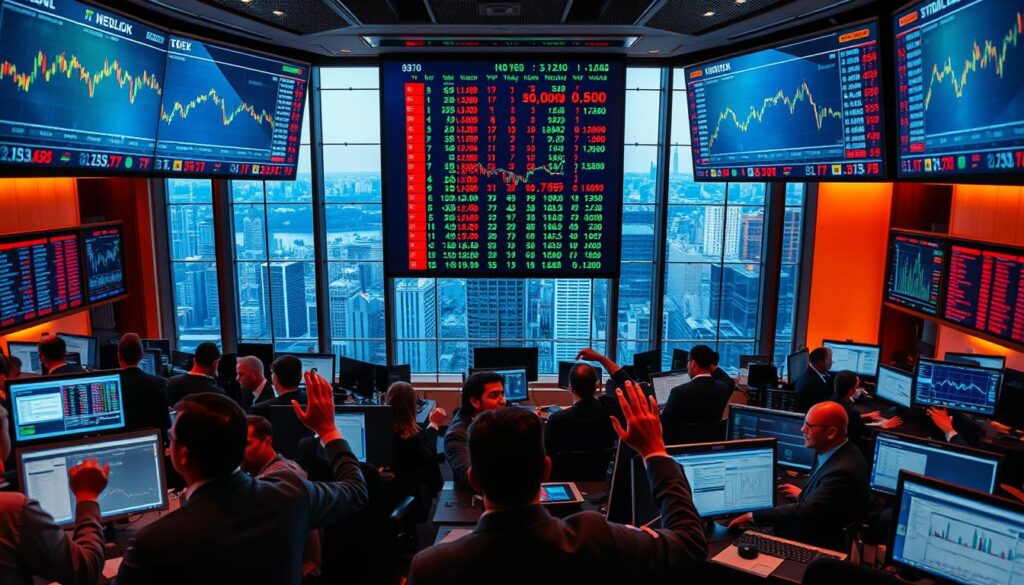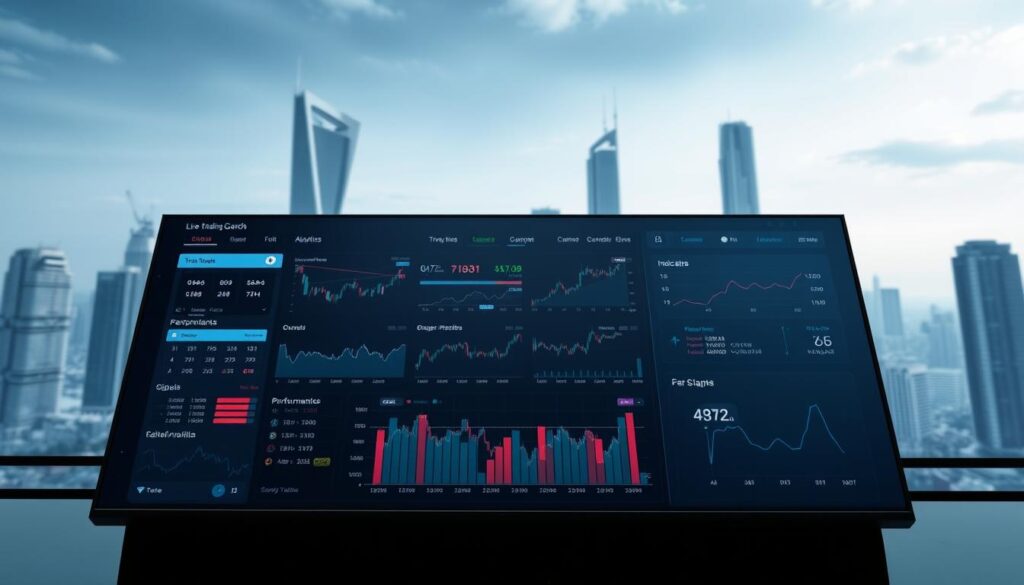Popular Trading Markets: A Comprehensive Guide
Financial markets serve as the backbone of modern economies, connecting investors worldwide. These platforms enable individuals and institutions to buy, sell, and grow their wealth across borders. For Vietnamese investors, understanding these opportunities is key to building a strong portfolio.
Exchanges like the NYSE and Nasdaq host companies with trillion-dollar valuations, such as Tesla. Accessing these platforms allows investors to tap into high-growth assets. Timing also matters—knowing when markets open in GMT+7 helps maximize opportunities.
Diversification across stocks, forex, and commodities reduces risk. This guide will break down major exchanges, tools, and strategies. Whether you’re new or experienced, knowledge empowers better decisions in a fast-moving financial world.
What Are Trading Markets?
Investors rely on regulated platforms to buy, sell, and grow their portfolios efficiently. These systems, called securities exchanges, ensure transparency and fairness in asset transactions. From stocks to currencies, they connect buyers and sellers globally.
Definition and Basic Mechanics
A stock exchange operates as a centralized marketplace. It uses two primary structures: order-driven (like NYSE) and quote-driven (common in Forex). The Tokyo Stock Exchange, valued at $6.56T, shows how these systems facilitate price discovery.
Liquidity varies by asset. Tesla averages 136M shares traded daily, while NVIDIA sees 279M. Such volumes highlight market depth, critical for investors seeking quick transactions.
Why Trading Markets Matter for Investors
The USD dominates 87% of global transactions, making it the backbone of currency trades. For Vietnamese investors, ASEAN corridors offer growth opportunities alongside major exchanges.
Trade execution follows a clear process:
- Order placement via brokers
- Matching bids/asks
- Settlement within 2 business days (T+2)
With 31% of S&P 500 firms listed on NASDAQ, understanding these mechanics unlocks access to high-value assets.
Types of Popular Trading Markets

Global financial opportunities come in diverse forms, each with unique risks and rewards. Investors diversify across asset classes to mitigate volatility and capitalize on growth trends. Below, we explore the three primary categories.
Stock Markets
The stock market hosts giants like Apple ($3.17T cap) and volatile tech shares like NVIDIA. Blue-chip stocks, such as Microsoft (beta 0.70), provide stability, while derivatives offer leveraged exposure.
Liquidity varies widely—Tesla trades 136M shares daily. For Vietnamese investors, ASEAN-listed firms add regional diversification.
Forex (Currency) Markets
Forex dominates with $6.6T daily volume, dwarfing equities. Major pairs like *EUR/USD* attract institutional players, while *USD/VND* suits local arbitrage strategies.
The USD drives 87% of transactions, but emerging currency pairs present niche opportunities.
Commodities Markets
Gold’s $13T safe-haven status contrasts with crude oil’s geopolitical swings. Brent crude pricing reflects global energy demand, while Vietnam’s rubber and coffee exports gain traction.
Agricultural commodities follow seasonal patterns, requiring specialized trading tactics.
Top Global Stock Exchanges by Market Cap

Market capitalization reflects the economic influence of leading exchanges. These hubs list high-value assets, from tech giants to energy titans, shaping global investment flows. Vietnamese investors can leverage these platforms for diversified portfolios.
New York Stock Exchange and Nasdaq
The NYSE operates as the world’s largest stock exchange, with a $31.58T market cap. It hosts 2,800+ companies, including Walmart ($774B). Blue-chip stability meets retail accessibility here.
Nasdaq rivals at $30.61T, fueled by tech like Microsoft ($3.37T) and Apple. Its electronic model appeals to growth-focused traders. Both exchanges set trends for global markets.
Asian Powerhouses: Shanghai and Tokyo Exchanges
Shanghai’s exchange boasts a $7.19T cap, while Shenzhen focuses on tech ($4.53T). China’s markets blend manufacturing and innovation sectors.
Japan Exchange Group trades from 09:00–15:00 JST, with a $6.56T footprint. Its precision electronics and automotive listings attract long-term investors.
Emerging Markets: India and Saudi Arabia
India’s Bombay Stock Exchange hits $5.26T, with 501M monthly trades. It’s a gateway to BRICS economies, offering growth potential.
Saudi Exchange runs 10:00–15:00 AST (GMT+3), anchored by Aramco’s $2.73T valuation. Cross-listings here may benefit Vietnamese investors eyeing Middle East expansion.
Profitable Stocks in Popular Trading Markets

Tech innovators and established giants dominate investor portfolios worldwide. Choosing the right mix of high-growth and stable assets can optimize returns while managing risk. Below, we analyze top performers across sectors.
High-Growth Tech Stocks
NVIDIA leads with a 146.27% YoY revenue surge, fueled by AI demand. Its $3.3T valuation and 135.34 P/E ratio reflect investor confidence. However, such metrics also signal premium pricing.
Tesla contrasts with a -53.53% EPS drop, yet its $1.12T cap shows market faith in long-term EV growth. Its 191.20 beta warns of volatility, suited for risk-tolerant traders.
Palantir’s $307B defense-tech niche appeals to those betting on government contracts. For Vietnamese investors, Samsung Electronics’ local listings offer indirect exposure to global tech trends.
Stable Blue-Chip Companies
Microsoft delivers steady gains with a $12.94 EPS and cloud-computing dominance. Apple’s $6.41 dividend yield attracts income-focused buyers, balancing its slower growth.
UnitedHealth’s $279B cap and 2.70% dividend exemplify healthcare stability. JPMorgan’s 1.92% yield adds financial-sector reliability to diversified portfolios.
Amazon’s $2.23T e-commerce empire outpaces Alibaba, though both face regulatory scrutiny. These giants suit investors prioritizing long-term capital preservation over rapid gains.
How to Choose the Right Market for Your Goals

Selecting the right financial platform requires aligning personal objectives with market dynamics. Investors achieve this through a two-step process: evaluating risk capacity and defining time horizons. Vietnamese participants should consider both global trends and local regulations when building strategies.
Assessing Risk Tolerance
AMD’s 1.87 beta versus Pfizer’s 1.17 shows how volatility varies across sectors. High-risk assets like crypto may suit aggressive portfolios, while Walmart’s stable EPS appeals to conservative buyers. Boeing’s -406% earnings plunge demonstrates sector-specific dangers.
Position sizing matters too. Coinbase’s $67B market cap suggests liquidity for large trades, whereas small caps require careful entry/exit planning. Vietnamese investors should note their 15% capital gains tax when calculating potential returns.
Rebalancing using S&P 500 weights (24% tech, 14% healthcare) maintains target risk status. Geopolitical factors like ASEAN trade agreements may reduce emerging market risks for local participants.
Short-Term vs. Long-Term Strategies
Day traders capitalize on Uber’s 795% YoY swings within a week, while Buffett-style “forever holds” target dividend stocks. The former requires constant monitoring, the latter benefits from compounding.
Dollar-cost averaging smooths entry points in volatile assets like Bitcoin. Swing traders might exploit NVIDIA’s 146% surges, while income-focused investors prefer Microsoft’s steady $12.94 EPS.
Vietnamese participants should align strategies with available time. Global trading sessions may conflict with local hours, affecting real-time decision capacity. Tools like limit orders help manage this challenge.
Trading Hours and Market Sessions

Global financial activity follows distinct time patterns that shape investment opportunities. For Vietnamese participants, understanding these cycles helps capitalize on peak liquidity and volatility. Sessions span Asian, European, and US hubs, each with unique advantages.
Understanding Time Zones and Liquidity
The NYSE runs 14:30–21:00 UTC (21:30–04:00 GMT+7), while London’s 08:00–16:30 UTC aligns with Vietnam’s afternoon. The 14:30–16:30 GMT+7 overlap between these markets sees 70% of daily currency trades, especially USD-pairs like EUR/USD.
Asian markets (01:30–08:00 UTC) suit local stock entries. Shanghai pauses for 1.5 hours, unlike continuous trading on NASDAQ. Pre-market activity (13:00 UTC) often signals opening trends for tech stocks.
Best Times to Trade for Vietnamese Investors
Optimize VND forex trades during London’s session, when USD liquidity peaks. For US stocks, pre-market scans at 20:00 GMT+7 reveal gaps before the NYSE opens. After-hours moves (like AMC’s +80% swings) carry higher spreads and risk.
Crypto operates 24/7, but major altcoin rallies often coincide with US hours. Traditional exchanges offer stability, while digital assets demand constant monitoring. Balance both based on strategy and availability.
Essential Tools for Trading Success

Smart investors equip themselves with powerful tools to navigate financial opportunities. The right combination of platforms and analytical resources can make the difference between guesswork and informed decisions. Vietnamese participants should evaluate these products based on local accessibility and global capabilities.
Brokerage Platforms
Robinhood’s $54B valuation reflects its appeal to casual investors, while Interactive Brokers serves professionals. Key differences emerge in:
- Commission structures (Fidelity’s $0 vs Saigon Securities’ 0.15%)
- Asset coverage (stocks, crypto, or local VND pairs)
- API access for automated processes
Vietnamese investors should verify platform status with the State Securities Commission. Some international brokers restrict services in emerging markets.
Analytical Resources
TradingView dominates charting with 50+ technical indicators, ideal for tracking NVIDIA’s RSI patterns. Bloomberg Terminal ($24k/year) offers institutional-grade data, while free alternatives like Investing.com suit beginners.
Effective analysis combines:
- Real-time news feeds (Reuters vs local sources)
- Backtesting software for strategy validation
- Risk management tools (stop-loss orders, options hedging)
Vietnamese-language communities provide localized insights, helping interpret global trends through regional perspectives.
Taking Your First Steps in Trading
Beginning an investment journey requires clear steps and practical tools. Vietnamese investors should start by opening accounts with local brokers like SSI or VNDirect, verifying licenses with the State Securities Commission.
A balanced starter portfolio might include 60% ETFs (VN30) and 40% blue-chip stocks like VinGroup. MetaTrader 5’s paper trading feature helps practice without risk.
Journaling trades—recording entry points and emotions—sharpens decision-making. For US-listed financial products, review SEC 10-K filings to assess company health.
HOSE’s free seminars explain market mechanics, while Vietnam’s 15% capital gains tax requires careful tracking. Small, educated steps build lasting confidence.

